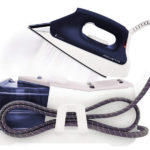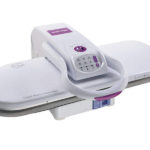This post contains affiliate links which will enable us to earn some commission if you click and buy.
If a chore is already one that you dread doing, what makes it worse is to have to deal with annoying issues. For ironing, one of these annoyances is having the iron sticking to the garment. While you desperately want the wrinkles to be gone, the iron soleplate gets sticky and creates even more wrinkles to the garment that you are ironing. So, you start to get frustrated and the problem doesn’t really get resolved. That is why some people rather switch to using a fabric steamer. After all, fabric steamers have also evolved to give better results and there are quite a few good ones on the market such as the Rowenta X-Cel Steam.
But if you don’t want to splash money on another appliance, you will need to find out why does your iron get sticky and if you will need to clean the soleplate. You will need to resolve the issue because a smooth glide makes ironing easier and faster to complete.
Why Is My Iron Sticking To The Garment

Temperature Is Too High
When I first started ironing years ago, I also had a sticky soleplate problem. I didn’t have the best Rowenta iron then but it was a Rowenta nonetheless. As such, I was thinking it shouldn’t be giving me such problems. But being a noob at the chore, I thought turning the iron to its highest setting will enable me to finish the task faster. The hotter is the soleplate, the easier it is to erase the wrinkles and set the creases. Well, how wrong was I!
In actual fact, you have to match the temperature of the iron to the type of fabric. If the iron is too hot, it could be the reason why your iron gets sticky and cannot glide smoothly across the garment. The usual recommendation is to start at a low setting for more delicate clothing and work your way up to the hotter setting needed for cotton and linen in your laundry pile. The reason for this is that steam irons tend to heat up faster than it cools down. So, it makes more sense to start at a lower temperature.
Basically, you have to adjust your fabric or temperature setting correctly on your iron. Just be aware that if the soleplate is too hot, it will stick to the garment that you are ironing. If you have a blended fabric, choose the setting that is lower for the different fabric type.
Starch Usage
If you use starch for your clothes, it could be another reason why your iron gets sticky. If you want to use it, the right way is to spray it on the reverse side of the clothes that you are going to iron. This is to avoid direct contact of the soleplate with the starch which will cause the stickiness.
Residue Build-Ups
Apart from starch, there may be other residue build-ups such as synthetic fibers on the soleplate of the iron as you use it over time. Rubber prints of fabrics may also get stuck onto the soleplate although you should always iron on the reverse side of the prints. To regain the smoothness, you would have to clean the soleplate and get rid of the starch and other residues.
Scratches
If your iron soleplate is scratched, it may contribute to the stickiness. Take care of your iron by not ironing directly onto zippers, buttons and other metallic items that could be attached to your clothes. Some irons also have a layer of nonstick coating on the soleplate. If that layer is destroyed, the iron may not have the same smoothness as before.
How To Clean Your Iron Soleplate
Even if you have the best steam iron, it still requires a clean soleplate for a more enjoyable ironing experience. While there are many methods to get rid of gunk and residues on your iron, the best way is to refer to your instruction manual on care and maintenance. This is because not all cleaning solutions are suitable for your iron. Different types of soleplates may react differently to such solutions. The worry is they may mar the coating on the soleplate which makes the stickiness even worse over time.
The obvious items to avoid for cleaning purposes is abrasive cleaners and scouring pads. Also, ensure that the iron is unplugged before cleaning. Generally, you can just wipe the soleplate with a soft damp cloth or sponge. Try doing it while it is still slightly warm. At most, use a sudsy cloth and then wipe it dry.
Another common method is to use a paste of baking soda and water. Wipe it with a damp cloth using the paste. You can also use a mixture of vinegar and distilled water since the former is well-known for its cleaning properties. The measurements are a quarter of vinegar to three-quarters of distilled water. For the steam vents, use a cotton bud to clean the grooves.
Again, the reminder is to check your instruction manual before you attempt cleaning with baking soda or vinegar solutions. It may not spoil your soleplate if it is stainless steel or aluminum but if it has a special nonstick coating, you have to be careful what you are using to clean it. Once your soleplate is marred, you can’t do anything about it but to replace your iron.




What can I put on the plate of the iron to make it glide over the material better ?